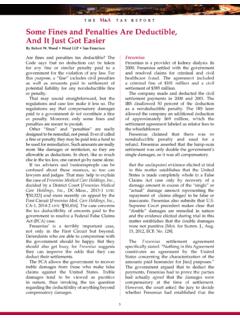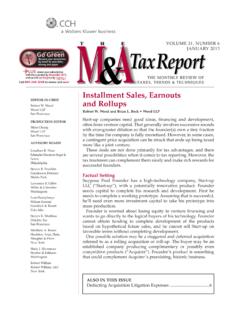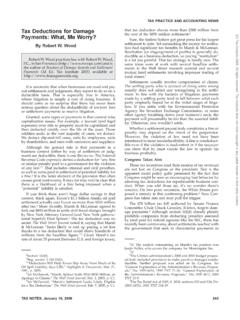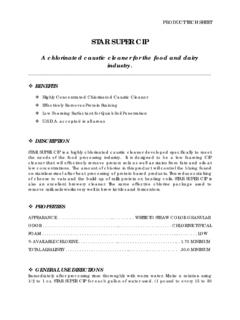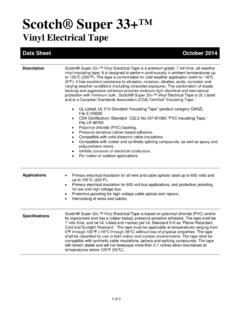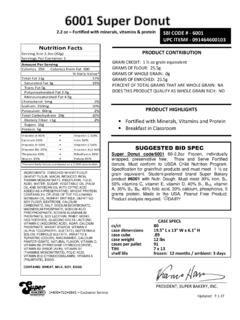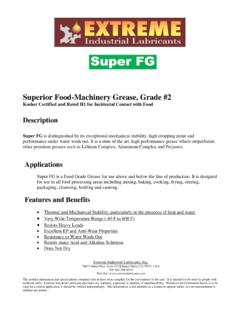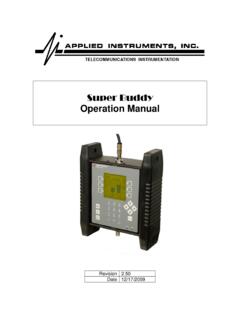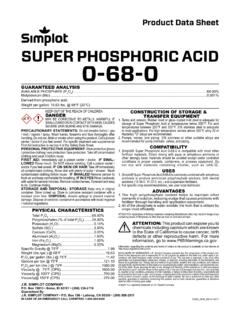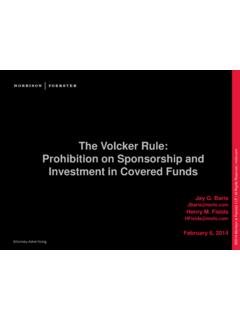Transcription of Passthrough and Joint Venture Tax Planning - …
1 TheThe Monthly Review of Taxes, Trends & TechniquesAugust 2012 Volume 21, Number 1 Tax Report+PLUS renew your subscription with the e version by November 2012, and we will cut the price by 10%!Call 800-248-3248 to renew and save!Receive your newsletter by email to save time, money and Save 10%MAMAMA&EDITOR-IN-CHIEFR obert W. Wood Wood LLP San FranciscoPRODuCTION EDITORA lexander Slotnick Wood LLP San FranciscoADvIsORy BOARDJ onathan R. Flora Schnader Harrison Segal & Lewis PhiladelphiaSteven R. FranklinGunderson DettmerMenlo ParkLawrence B. Gibbs Miller & Chevalier WashingtonIvan Humphreys Wilson Sonsini Goodrich & Rosati Palo AltoSteven K. Matthias Deloitte Tax San FranciscoMatthew A. Rosen Skadden, Arps, Slate, Meagher & Flom New YorkMark J. Silverman Steptoe & Johnson WashingtonRobert Willens Robert Willens, LLC New YorkPassthrough and Joint Venture Tax PlanningBy Jonathan Van Loo Wood LLP San FranciscoIt seems nearly a generation ago that M&A practitioners worried only about corporations, usually C corporations at that.
2 The tax law seemed to make sense then, with terminology and techniques that, if not easy, at least were practiced. There were the corporate reorganization rules, with their alphabet soup of offerings. There were also taxable stock and assets deals, and in 1982, Congress enacted Internal Revenue Code Section ( Code Sec. ) 338. That shiny new provision would make it a snap to elect asset purchase treatment even if you bought stock. What a simple and streamlined thing that would be, obviating the old buy and liquidate within two years rule of Code Sec. 334(b)(2). Of course, we all know how simple Code Sec. 338 turned out to be, but still, it was a grand sea change of General Utilities repeal in 1986 meant that tax and corporate lawyers had to retool if not downright redefine themselves.
3 Passthrough entities became fashionable beyond the realm of real estate. Meanwhile, S corporations too were more attractive, but also became more complicated. And not too many years later, the advent of LLCs would reshape the choice of entity debate and the whole check-the-box concept would be born. These days, merely knowing something about corporate acquisitions and reorganizations may not qualify you for a seat at the table. You ll need at least passing familiarity with the Passthrough rules in nearly every kind of deal. And learning about them and keeping up with developments can be daunting. This is all the more true in light of the astonishing variety of Passthrough tax entities, each with its own set of rules: S corporations, REITs, RICs, REMICs, publicly traded partnerships and disregarded entities (which are almost always disregarded).
4 The annual Practicing Law Institute (PLI) conference on tax Planning for partnerships and Joint ventures provides an excellent way to get up to speed on partnership developments. PLI sponsored The M&A TAx RepoRTCCH Journals and NewslettersEmail Alert for the Current Up ReportMAMAMA&The Monthly Review of Taxes, Trends & Techniques2 EDITOR-IN-CHIEF MANAGING EDITOR Robert W. Wood Kurt Diefenbach COORDINATING EDITORTara FarleyM&A Tax Report is designed to provide accurate and authoritative information in regard to the subject matter covered. It is sold with the understanding that the publisher is not engaged in rendering legal, accounting, or other professional service. If legal advice or other expert assistance is required, the services of a competent professional person should be sought From a Declaration of Principles jointly adopted by a Committee of the American Bar Association and a Committee of M&A TAX REPORT (ISSN 1085-3693) is published monthly by CCH, 4025 W.
5 Peterson Ave., Chicago, Illinois 60646. Subscription inquiries should be directed to 4025 W. Peterson Ave., Chicago, IL 60646. Telephone: (800) 449-8114. Fax: (773) 866-3895. Email: 2012 CCH. All Rights Reserved. Permissions requests: Requests for permission to reproduce content should be directed to CCH, Photocopying or reproducing in any form in whole or in part is a violation of federal copyright law and is strictly forbidden without the publisher s consent. No claim is made to original governmental works; however, within this product or publication, the following are subject to CCH s copyright: (1) the gathering, compilation, and arrangement of such government materials; (2) the magnetic translation and digital conversion of data, if applicable; (3) the historical, statutory, and other notes and references; and (4) the commentary and other 2012 Conference for Tax Planning for Domestic & Foreign Partnerships, LLCs, Joint Ventures & Other Strategic Alliances in San Francisco.
6 It was co-chaired by Louis Freeman and Clifford Warren. It is held every year in San Francisco, New York and Chicago and is broadcast nationwide. It should soon be available as a Investment Funds for Sponsors and Outside InvestorsSome of the familiar topics covered in previous conferences were reprised. Partnership formation, noncompensatory partnership options and the disguised sale rules were addressed. Plus, this conference included several new panels. One was a panel on top-side Planning by private equity and hedge funds, presented by Eric Sloan of Deloitte Tax LLP and Lew Steinberg of Credit Suisse Securities ( ) LLC. The focus was on changes in private equity fund and hedge fund structures based on the tax attributes and tax preferences of major fund investors.
7 Fund investors consist of five major categories: tax-exempt investors, taxable investors, super tax-exempt investors, sovereign investors and taxable investors. The most important outside sources of capital are the super tax-exempt investors and sovereign investors. There is a who s-who that controls what each investor super tax-exempt investors are public pension funds claiming an exemption from federal income tax under Code Sec. 115. The super tax-exempts are not subject to unrelated business taxable income (UBTI) under Code Sec. 511 because their tax-exempt status does not derive from Code Sec. 501(c). However, query whether income that would otherwise be treated as UBTI would qualify for the exemption under Code Sec.
8 115 as income derived from an essential government function. In any case, the super tax-exempts are also generally exempt from the annual reporting requirements that apply to exempt organizations. [See Reg. (g)(v).] Then there are sovereign Code Sec. 892, sovereign investors also enjoy a broad exemption from tax. That includes most notably dividend withholding tax and gain from the sale of a domestic corporation that is a United States real property holding corporation under Code Sec. 897. [See Example 1 of Temporary Reg. ; Notice 2007-55, 2007-2 CB 13.] However, Code Sec. 892 investors can lose their special tax-exempt status if they earn even a single peppercorn of income from commercial activities.
9 It doesn t matter if the commercial activities income is earned from foreign sources. The investor loses its tax-exempt status even if it earns its income from sources. Under proposed regulations, the IRS has created safe harbors from the all-or-nothing commercial activities rules for sovereign investors. In certain circumstances, investors may conduct commercial activities inadvertently or through a limited partnership interest while still retaining their status as good Code Sec. 892 investors. These new safe harbors The M&A TAx RepoRT3provide a significantly more forgiving framework. Code Sec. 892 investors were previously subject to potential penalties for inadvertent compliance CountThe most important group of taxable investors consists of the fund sponsors (the individual fund managers who have a carried interest in the fund).
10 Rounding out the group of investors are taxable investors such as investment funds and foreign corporations as well as tax-exempt institutional investors such as private foundations and university endowments. Another important consideration when dealing with pension fund and retirement account investors is to avoid subjecting the investment fund to the plan asset rules under ERISA, which would impose fiduciary duties on the investment fund managers. Juggling the demands of this disparate group of investors in an investment fund can lead to complex structures with feeder funds. Separate feeder funds may be set up to accommodate each group s different tax issues. For example, tax-exempt investors normally do not like to make a direct investment if there is any leverage, because debt-financed investment income is subject to tax as UBTI.



